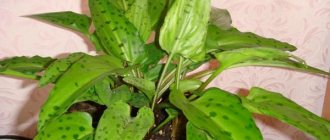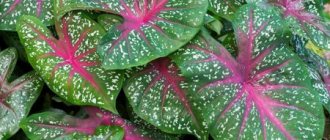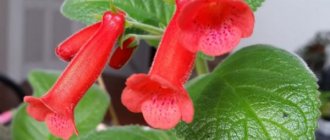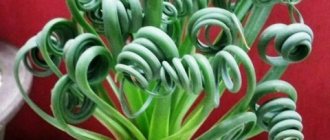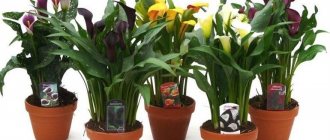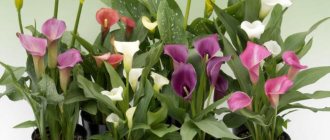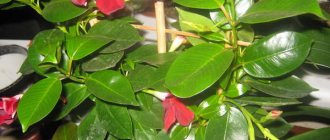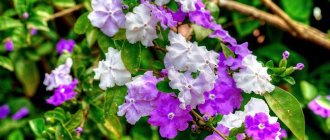This extraordinary flower, originating from the Cape region of South Africa from the Iris family (Irisaceae) and the genus Freesia, is sometimes called the Cape lily of the valley, and the official international scientific name - Freesia - was assigned to it (both the flower and the genus itself) in honor of either a German doctor or or the botanist Friedrich Frese (1795 - 1876), who, as stated in some sources, holds the honor of compiling the first description of this flower. He was also successful in breeding freesia.
Apparently, the freesia flower came to Europe in the 15th century, during the era of great geographical discoveries, when Europeans first laid sea routes to the southern hemisphere and the New World.
In Russia, aristocratic freesia quickly took root and has been successfully cultivated since the 19th century.
Description and origin of the flower
Freesia, a corm plant, belongs to the iris or iris family. This is a fairly tall plant - up to one and a half meters in height with long, up to 20 centimeters, leaves. They are usually about two centimeters wide and are painted bright green.
Funnel-shaped buds with a wonderful aroma are painted in different colors - from delicate white to purple. The buds are located on one side of the peduncle covered with scales, in most cases branched and curved.
The flowers are simple and double, large - from 3 to 7 centimeters. The brush usually contains up to 15 flowers. Freesia is a native of the Cape region of South Africa. Therefore, it is sometimes called “Cape lily of the valley” or “Cape lily”. It usually grows in floodplain forests of rivers, often forming real impenetrable thickets up to one and a half meters high.
The beautiful freesia arrived in Europe in the second half of the 19th century, and perfumers first became interested in it. And only at the very end of the century they began to grow it to decorate gardens and interiors.
Freesia received its name in honor of the German botanist and doctor Friedrich Friese, who was the first to discover this flower in the rainforests of South Africa.
A charming lover of moist, warm forests, freesia has long been grown only as a greenhouse plant. In recent years, species and varieties have appeared that can be grown in open ground in the southern and western regions of Russia. Freesia has won the love of not only landscape designers, but also florists - very often it is the main theme of bride’s bouquets.
2.Description - what freesia looks like and grows
The genus contains 19 perennial bulbous plants.
The conical bulbs reach a diameter of only 2.5 cm.
The leaves are green, xiphoid, erect, basal, 10 - 30 cm long.
Peduncles are tall, leafless, vertical, each bears several flowers , opening sequentially - from bottom to top.
The shades of the petals include the entire color gamut, except perhaps black. Varieties with flowers of contrasting tones have been bred.
Blooming freesia produces a very pleasant aroma . For this aroma, reminiscent of the smell of lily of the valley flowers, the plant was given a second name - Cape lily of the valley .
Height . 15 - 40 cm . The final size of the flower will depend on the varietal characteristics and maintenance conditions.
Interestingly, plants with red-yellow flowers grow the fastest.
↑ Up,
Types and varieties, photos
There are approximately 20 different species of freesia in the wild and a huge number of varieties. But for growing indoors, its cultivated species are the most suitable. The most common are the following:
- F. Armstrong, reaching a height of 65-70 centimeters. Its panicle inflorescences are painted in various shades of red - scarlet, pink. This species blooms from May to June. Among the mass of varieties, the most common is the Cardinal variety.
- F. broken is distinguished by its miniature size - up to 40 centimeters. She requires the most careful care. White and orange flowers appear in mid-spring. Popular varieties are Alba and Odorata.
- F. is a hybrid, which successfully combines all the best qualities of F. Armstrong and F. broken. Tall bushes, often reaching a meter in height, produce flower stalks in spring with large flowers, up to 10 centimeters in diameter, in various shades of red, yellow and purple. The best varieties for home cultivation are Red Lion, Vinita Gold, Royal Blue.
All types and varieties of freesia are characterized by long - up to one and a half months - flowering. To prolong this splendor, usually the first peduncle with half-opened buds is cut off and placed in vases; flowering continues on the second order peduncles.
Popular varieties for apartments with photos
There are several varieties of this fragrant plant, which have gained the greatest popularity among gardeners.
White or refracted
Freesia refracted (broken) or white (lat. Freesia refracta) is a herbaceous plant reaching 40 cm in height. The stem is branched, bears several belt-shaped leaves, 10-30 cm each. The inflorescence is loose, spike-shaped.
The buds are cream-colored with a golden core, directed upward.
Terry
Freesia Terry (lat. Freesia Double) is an incredibly spectacular variety, decorated with light blue buds interspersed with yellow. The leaves are narrow and elongated. An adult plant reaches 40 cm in height.
Armstrong
Armstrong's freesia (lat. Freesia armstrongii) is one of the highest varieties of this flower crop. Can grow up to 65 cm in length. The stem is thin, branched, the leaves are narrow and linear, the flowers are red in color with an orange throat and pink perianth.
Alba
Freesia Alba (lat. Freesia alba) is a perennial herbaceous plant with an erect branched stem up to 40 cm in height. Decorated with large beautiful yellow buds with purple splashes. The inflorescence is a broken spike, a stable peduncle up to 35 cm. Each plant acquires 10 flowers up to 7 cm in diameter.
Fragrant
Fragrant freesia (lat. Freesia refracta odorata) - this species has paniculate inflorescences consisting of 3-7 yellow buds, the bases of which are decorated with orange spots. The leaf blades are long and sword-shaped. The height of an adult plant is up to 65 cm.
A characteristic feature of fragrant freesia is the amazing aroma of lily of the valley.
Hybrid
Hybrid freesia (lat. Freesia hybrida) is an amazingly beautiful branched bush, up to 80 cm in height. The racemose inflorescences contain fragrant flowers up to 7 cm in diameter. They can be painted in a wide variety of colors. The most common colors are raspberry, yellow, and violet. There are monochrome and two-color.
Rose Marie
Freesia Rose Mary (lat. Freesia Rose Mary) is a type of hybrid variety. The height of the peduncles is about 25 cm. The inflorescence includes only 7 buds, 5 cm in diameter. The color is deep crimson with white.
Cardinal
Cardinal (lat. Freesia armstrongii Kardinal) is considered the most beautiful variety of freesia. The height of the bush can reach 70 cm. Its single flowers are painted red. From each bulb grows 3 peduncles, the panicle-shaped inflorescences of which consist of 11 buds, with the length of the inflorescences being about 9 cm.
This variety has dark red flowers with a yellow spot, blue pistil, yellow stamens and purple anthers.
Freesia growing and care at home
The main advantage of growing freesia at home is not only that it is possible in any climate zone. A big plus is that flowering occurs in the first days of April. You can get beautiful indoor flowers earlier - by the New Year, March 8th. This will depend on the timing of planting the bulbs.
Growing conditions
The main requirement is sufficient illumination. Therefore, for its placement, preference should be given to windows facing the sunny side.
Important! Freesia does not tolerate not only direct sunlight, but also a directly directed flow of light from additional illumination devices.
Pots with plants are shaded at any time of the year, using light translucent fabric or thin paper, preferably pure white.
The duration of daylight for freesia should be 14 hours a day, so it often needs additional lighting, especially in the winter months.
Freesia has a sharply negative attitude towards drafts, even in the warm season. Therefore, when ventilating the room, it is either moved to the next room or covered with plastic film, a cardboard partition, etc.
Freesia's soil requirements are also quite high. The substrate must have a neutral or alkaline reaction (ideally 6.0-6.8). It should be loose and nutritious and contain the following components: turf and leaf soil, humus, peat and sand.
In terms of nutritional value, the composition of the substrate for freesias is close to the soil for roses, however, its saturation with calcium, iron and magnesium in it should be reduced, and the amount of potassium and phosphorus should be increased.
Maintaining the required temperature is the most difficult part of caring for a plant.
Important! When growing freesia, it is necessary to constantly maintain a temperature of +22˚С from the moment the leaves appear.
When the first buds appear on the peduncles, freesia will easily tolerate higher temperatures. A native of the floodplain forests of South Africa, freesia loves not only well-moistened soil, but also high air humidity. At the same time, like all bulbous plants, it does not tolerate stagnation of water in the soil. Therefore, there must be a drainage layer of at least 2 centimeters at the bottom of the pot.
To better retain moisture in the soil, peat mulch is usually used. To maintain air humidity, open containers with water are placed next to the pots. Spraying freesia is also allowed, but only before the flower stalks appear: when water gets on the buds, they most often fall off.
Tall varieties of freesia also require support, especially F. broken, its stems are quite fragile (hence the name), and peduncles reach 70-80 centimeters in length.
Garden freesias: planting bulbs and seasonal care
There is no concept of indoor freesia or garden freesia. This is one plant that, given the right conditions, can be grown both in a pot and in the garden.
When and how to plant plants
In central Russia, freesia bulbs are planted in early or mid-April in a place where there is no direct sun, i.e. in partial shade. Freesia is light-loving (it needs light 12 hours a day), but cannot stand the bright sun. If you plant the bulbs later, there is a high risk of getting flower stalks that are too weak or not visible at all. Freesia germinates, gains green mass and throws out a peduncle at a temperature of 15 degrees Celsius, but abundant flowering should occur at a higher temperature - 25 degrees.
Blooming white freesia in the garden
Some gardeners suggest first germinating freesia at home, before finally planting it in a flowerbed, but this step is not mandatory in the agricultural technology of this plant. When starting planting, it is advisable to clear the bulbs of scales and pickle them in a solution of potassium permanganate for 30 minutes (2 liters of water on the tip of a knife) or any fungicide according to the instructions, since if this is not done, adult plants may be affected by thrips or fungal diseases. Bulbs that are damaged or have spots are discarded. Next, the bulbs are planted in a pot at the end of February in fertile soil (as experienced gardeners suggest), or directly into the ground no later than mid-April.
Dressing the bulbs in a weak solution of potassium permanganate will protect them against fungal diseases and rot.
Video: preparing freesia bulbs for planting
The planting scheme is as follows: depth - 3 cm, distance between plants - 3-5 centimeters, row spacing - 15 centimeters.
It is worth considering that freesia does not tolerate stagnant water, so the plant must be provided with good drainage. To do this, draw a furrow 15 centimeters deep, scatter expanded clay in 1 layer at its bottom, cover it with nutrient soil, place the bulbs on it with their sprouts facing up (or lay out already sprouted plants with leaves with a lump of earth), and sprinkle with soil until the end of the furrow.
Planting pre-sprouted freesias in open ground
Video: planting freesias in open ground
How to care during growth and flowering
If freesia is planted in fertile soil, there is no need to overdo it with fertilizing - freesia does not react well to excess fertilizer, but after germination the plants need to be fed with ammonium nitrate (20 grams per bucket of water), and then, if desired, fed once or twice a month plant fertilizer for flowering ones.
Weeding and loosening is another important point in growing freesia. During the period of active growth and appearance of the peduncle, freesia is watered very abundantly. The soil should not dry out, but stagnation of water should also be avoided.
Abundant flowering of freesias in the garden
Freesia is a fragile plant, its flower stalks easily break under the weight of the flowers, therefore, as soon as the leaves begin to fall apart, they need to be supported using stretched twine.
Example of freesia twine
If the temperature outside has risen high and the air humidity has dropped significantly, freesia is sprayed with a spray bottle. It is important to do this in the evening or very early morning: the leaves must have time to absorb moisture.
Watering freesia by sprinkling or spraying provides the necessary moisture to the plant
Freesia can be affected by diseases and pests that are characteristic of gladioli: spider mites, thrips, aphids, fusarium, scab and various rots. Plants affected by fungal diseases are immediately removed from the flowerbed. Disinfection at the beginning of storage and before planting solves all these problems. And insecticides control pests at an early stage of detection.
How to prepare a plant for winter + storing bulbs
As the flowers drop and the tops wither, watering is reduced, and then stopped altogether, leaving the bulbs until the first possible frost in the ground (early October). In central Russia, freesia cannot withstand wintering in the ground. In the south, the bulbs can be left to overwinter in a flower bed, but this is still very risky. If you decide not to bother with digging, then the freesias need to be covered with a 20-centimeter layer of mulch made from straw or fallen leaves, but this may not save the bulbs from frost.
The most reliable way to preserve the bulbs until the next season is to dig them up, cut off all the leaves, wash them, place them in a weak solution of potassium permanganate for an hour and leave them to dry in a dry room for up to 5 days.
Laying freesia bulbs for further storage
To prevent the bulbs from getting lost in the ground, and to make it easy to remove them from there, there is one tricky but very convenient technique: the bulbs are planted in boxes with holes all over the surface, and then they are dug into the ground. Citrus fruits are supplied to supermarkets in such boxes. Firstly, by planting bulbs in boxes, you will provide the plants with good drainage by scattering expanded clay on the bottom, and will not clog the soil in the flowerbed with it. Secondly, with the onset of cold weather, the box can be easily removed from the flowerbed, and finding all the mother and daughter bulbs in it to the last will not be difficult.
Using the example of tulips planted in boxes, you can see how bulbous plants are planted in boxes that are buried in the ground
Bulbs are stored at a temperature of 20–25 degrees and at high humidity (60–70%) - this is the most important condition for the formation of a future peduncle in the bulb. Mother and daughter bulbs should be immediately separated from each other. The mother bulb will give color next season, and the daughter bulb will give color in a year, but only if it is planted at the same time as the mother bulb, but in a separate place. To feel the breath of spring in winter, some of the collected mother bulbs can be planted in a pot on your windowsill. This is called spring forcing of freesia.
blooming freesias in a pot on the windowsill
Solving problems that arise when growing freesia in the garden
Freesia has one peculiarity: it must go through a long period of rest of 3 months at high humidity and temperature. If this condition is violated, the bulb has not gained enough strength, and therefore will not sprout at all, and when digging it up, you can find the formation of several daughter bulbs.
The reason why freesia does not bloom is also due to poor temperature conditions. And such a plant will not be helped by any feeding, transplanting or anything else. As a rule, sellers store the bulbs in the refrigerator, so they need to be warmed up. In addition, freesia will not throw out a peduncle if the entrances have already appeared, but sudden bad weather occurred and the temperature dropped below three degrees Celsius. Also, if the temperature is too high in the first 5 weeks, freesia refuses to bloom. Mid-May is already too late for planting freesia in the garden.
If freesia's leaves lie down, it means the temperature outside is too high. The reason for the yellowing and drying tips of the leaves of the plant is excessive or insufficient watering. At low humidity, the plant also gives a signal by turning yellow tips of the leaves. In addition, a large number of fertilizing may not have the best effect on the condition of the plant.
How to plant freesia at home
You can grow beautiful freesia using two main methods of propagation: from seeds or from bulbs. Moreover, the latter method involves both using a daughter bulb as planting material and dividing the mother bulb.
Growing freesia from seeds
Freesia seeds are usually sown in April-May.
Important! The fresher the seeds, the better their germination.
Before planting, they are kept for a day in a pale pink solution of potassium permanganate at room temperature. Planting is carried out in seedling boxes or containers, preferably with steamed compost. Ready-made soil for freesias is also suitable. Then the containers are covered with polyethylene. Ventilate mini-greenhouses daily for at least 20 minutes.
Sprouts appear in about 3-4 weeks. If necessary, they are given extra light, watered regularly, the soil is lightly loosened, and fertilizers containing potassium and phosphorus are applied weekly. The grown sprouts are planted in separate paper cups or in separate pots.
Important! Self-collected seeds do not guarantee the production of plants with the varietal characteristics of the parent plants.
Growing freesia from bulbs
Interesting! Depending on the planting of the bulbs, flowering freesias can be obtained for various holiday dates in winter:
- for bright New Year's holiday decorations, the bulbs are planted at the very beginning of September;
- for February flowering (for Valentine's Day), the planting date will be early October;
- A festive fragrant bouquet of freesias for March 8 begins to be grown in the last 7-10 days of October.
The timing of planting freesia corms may vary. Some varieties require a longer forcing period - 5-6 months.
Important! Freesia bulbs must rest for at least three months before planting!
The best results are obtained by bulbs of the 1st and 2nd parsings, that is, the largest ones. Before planting, the bulbs are soaked in a disinfectant solution. It is prepared from azotobacterin, or potassium permanganate, or boric acid. Azotobacterin take 0.05 g of the drug per liter of water, potassium permanganate or boric acid will be enough at 0.01 g per liter of water.
After soaking for an hour, the bulbs are washed with running water and treated with root formation stimulants (Epin, Kornevin or home remedies).
Pots intended for planting freesias should be deep, up to 30 centimeters, with a diameter of 15-18 centimeters (4-6 bulbs are planted depending on the size). They must be clean and disinfected.
At the bottom of the container, lay a layer of expanded clay, or pieces of brick or pebbles mixed with charcoal or wood ash. This additive will prevent acidification of the soil or the appearance of rot.
Then soil is poured into the pots. It is advisable to place a stick of long-acting potassium-phosphorus fertilizer under the place where the bottom of the onion is supposed to be. This stick will eliminate the need for regular fertilizing.
The bulbs are planted at a distance of 5 centimeters from each other. The planting depth of the bulbs in the pot is also 5 centimeters. Cover the bulbs with loose soil. Pots with planted bulbs are kept in a cool room - +15˚С.
Important! During the period of rooting and germination of the bulbs, neither watering nor fertilizing is carried out. As soon as the first shoots appear, the pots are moved to a well-lit, warm place and begin to be watered.
Growing freesia from seeds
In mid-April, freesia can be grown from seeds. Seeds soaked in a solution of potassium permanganate are planted in the ground. Three weeks later, shoots appear, after which the seedlings are transferred to a warmer place and grown under the light of phytolamps, regularly watered and fed.
For feeding, take a liquid preparation containing a complex of elements, primarily potassium and phosphorus. The fertilizer is diluted with water and applied once every 10 days. The grown plants dive into separate pots. If desired, freesia grown from seeds is planted in a garden bed.
Basic rules of care
The main care measures when growing freesias are additional lighting during the short daylight hours in autumn and winter, installing supports for flower stalks, watering and spraying, maintaining humidity and air temperature, and fertilizing.
Important! Water the freesias with water at room temperature, standing for at least two days!
Water the plants every other day, but moderately. Excess water that has flowed into the pan is drained to prevent waterlogging of the soil. Both watering and spraying are best done in the morning.
Freesias are fed with potassium- and phosphorus-containing fertilizers from the moment the buds appear until the leaves almost completely turn yellow. The frequency of feeding is once every two weeks.
Features of freesia
In nature, the plant prefers shady places on river banks. This trait was preserved in subsequently bred hybrids - freesia loves warmth, humidity and crowded planting, but direct sunlight is undesirable for it.
The southern guest has elongated narrow leaves with a midrib, and its buds form inflorescences, sometimes quite weighty. There are many color options: from delicate pastels to bright, saturated ones.
For its recognizable aroma and historical homeland in the Cape Province of South Africa, freesia is called the Cape lily of the valley. It is interesting that different varieties may differ in intensity and shades of smell, but the main note remains unchanged and has been inspiring perfumers for many years.
Flowers are good for cutting - in a bouquet they retain their aroma and freshness for at least a week, but florists assure that with proper care they will last up to 10 days.
Planting freesia bulbs in pots in spring
Typically, bulbs are planted in pots in spring in regions with short summers. The planting process is identical to the autumn one.
Pots with seedlings are placed in the open air - a balcony, a veranda, or a garden. In this case, the place for the pots should be chosen taking into account all the requirements for growing freesias:
- light partial shade;
- reliable wind protection.
In this case, by autumn the freesias will produce flower stalks. It would be advisable to bring the pots into the house (apartment) in mid-August. At the end of the month or in the first week of September, the plants will begin to actively bloom.
Description of the flower
A beautiful flowering plant. The leaves are linear, the flowers are funnel-shaped, fragrant. Flower height is from 30 to 60 cm. The flowers are quite large, of various colors. The flower owes its name to the German doctor Frees.
Belongs to the corm plants of the Iridaceae (Iris) family. It grows mainly in the Cape region of South Africa and tropical zones of Africa. One of the species was brought from Sudan. Under natural conditions, the bulbs lie dormant in the ground for a long time until the rainy season begins. With the advent of moisture in the soil, they begin to actively develop and produce flower stalks with beautiful flowers. During drought, the aboveground part dies off completely, and the bulbs go into a dormant state.
Interesting! Freesias were brought to Europe a long time ago - two centuries ago. They were actively cultivated in gardens, then migrated to window sills and began to be grown as a houseplant. Freesia contains essential oils used in perfumery. When cut, the flower remains fresh for a long time.
Caring for freesia after flowering
After the end of flowering, at the beginning of the process of yellowing of the leaves, the peduncles of freesias are removed. Watering nevertheless continues to allow the bulbs to acquire daughter bulbs.
Stop watering 6 weeks after removing the flower stalks. When the substrate in the pot is completely dry, the bulbs are dug up, washed in a solution of potassium permanganate, excess scales are removed and dried.
Reproduction methods
The flower can be propagated in several ways. Seed propagation is rarely used; seedlings often do not repeat the maternal properties of the variety. This method pays off when you need to obtain a large number of young seedlings. To obtain seed pods, the plant must be artificially pollinated.
Freesia seeds
Ripened seeds are pickled with a raspberry solution of potassium permanganate for 20 minutes. Prepare a light substrate. The best sowing time is March. Sowing is carried out to a depth of 10 mm, and the top is covered with film or glass. The plantings are ventilated daily. The first seedlings appear after 2 weeks.
Reproduction by dividing the corm. Using a sharp, clean knife, divide a healthy tuber into 2-3 parts, sprinkle the cut areas with crushed coal and dry them. Each division must have at least one bud. Plant each part in a separate container with bulbous substrate.
Freesia bulbs
Reproduction by tubers. On an adult tuber, daughter bulbs are formed, which are carefully separated and planted in a soil mixture of peat, sand and turf soil in a 1:1:1 ratio.
Note! Reproduction by children is the easiest way to increase the number of plants while maintaining varietal properties.
Bulb storage
The dug up and processed freesia bulbs are sorted by size and placed in nets or bags made of rare fabric. If there are a lot of onions, you can put them in a wooden or plywood box.
Storage temperature 20-25˚С, air humidity 80%. If the humidity in the room is lower, place an open container filled with water under the container where the bulbs are located. At least once every 4-5 weeks, the bulbs need to be sorted and carefully examined in order to promptly detect the onset of diseases or rotting processes. You can also store the bulbs in boxes, sprinkled with dry peat, this reduces the risk of putrefactive processes.
Important! Storing bulbs in the refrigerator is not allowed.
Before planting, 4-5 weeks before planting, the bulbs are moved to a cooler room, with a temperature of no more than +15˚C.
Selection and preparation of freesia bulbs
It is best to purchase garden freesia corms from a reputable garden center or specialty store. When choosing planting material, you must carefully examine the tubers - they should be hard and dense, without traces of mold, rotting, or any damage, and there should be no dry or soft areas on them .
The photo shows good bulbs:
Before planting them in the spring, it is recommended to prepare the bulbs:
- The first step is to clear them of scales . However, the scales that cover the tip of the bulb do not need to be touched! If under the scales you see that the bulb is dry or rotten, then you need to discard it; naturally, nothing will grow from it.
- disinfection should be carried out - soak in a fungicide solution, for example, the drug “Fitosporin-M” is effective (follow the instructions). This treatment is necessary to eliminate pathogens from the surface of planting material. In addition, the procedure will make the planting material more resistant to diseases and rotting.
- After disinfection, you can treat the freesia bulbs in a solution of a growth stimulant drug , for example, Epin-Extra, Zircon, Heteroauxin, you must follow the instructions. This preparation makes the planting material more resilient and helps it germinate faster.
- If you do not want to soak in a growth stimulant, then after disinfection, to stimulate growth, you can simply gently moisten each bulb in aloe juice (if you first put the plant leaves in the refrigerator for 10 days, the juice will be even more effective).
Advice! If you find babies on the corms, you don’t need to tear them off yourself. It is better to plant directly with them.
Pests and diseases of freesia
When grown at home, freesia can be attacked by common pests of indoor plants - spider mites, aphids, thrips. All of them are sap-sucking, and parasitize on plants, feeding on their juices, depleting them. Thrips, moreover, often carry pathogens of viral diseases.
If there are a small number of pests, they are usually removed by hand, and then the plants are treated with a solution of laundry soap, infusions of garlic or onions with vodka or alcohol. If there are a lot of pests, they resort to chemicals - Actellik, Fitoverm.
Important! In most cases, pests appear on freesias as a result of non-compliance with care rules.
Among the diseases of potted freesias, the most common are fusarium, various rots, and scab. Pre-planting disinfection of bulbs and seeds is designed to reduce the risk of disease. For the same purpose, charcoal or ash is added to the substrate.
When a disease is detected, freesia is first isolated from other plants. Then it is dug up and the bulb is processed. If the damage is significant, the diseased specimen must be destroyed.
If you carefully follow all the rules of care, watering regimes, temperature and humidity, freesias get sick very rarely.
Propagation of freesia by bulbs
In nature, Cape lily of the valley can reproduce by seeds and vegetatively. But hybrid varieties are often sterile, so corms and tubers (babies) are taken to produce garden flowers.
The baby does not bloom in the first summer - it only produces leaves and forms the buds of future flower shoots, turning into a bulb. During the second growing season, the buds bloom and the tuber itself dies, although a new one develops instead.
During the flowering period, the corm stores nutrients. At this time, replacement bulbs and buds grow intensively, so the plant needs watering, the intensity of which should be reduced by the end of September.
Growing problems
The most common problem that gardeners face when growing freesia is the lack of flowering. This occurs even more often than diseases or pest attacks. The lack of flowering is usually associated either with the age of the bulb - it has not reached the required degree of maturity, or with violations of the temperature conditions of storage, rooting and germination of planting material.
In the first case, there is nothing terrible; at the end of the season, the bulbs are dug up, processed and sent for storage. They are planted for the next season.
In the second case, freesias actively expel foliage, and perhaps even flower stalks with buds appear. But the buds either fall off after a short time or turn out to be empty. In this situation, again, you should dig up the bulbs, examine them for diseases and store them.
Care after spring planting of freesia
Caring for freesias after planting in open ground in the spring is necessary for normal growth and development, and beautiful flowering. The agricultural technology for growing Cape lily of the valley is very simple. To properly care for flowers, it is enough to fulfill a number of simple requirements:
- Regular watering. It is necessary to regularly water the plants from planting to a permanent place until the end of flowering (after which it stops). The plant does not tolerate a lack of water very well, so in hot and dry weather it should be watered almost every day.
- Humidity. The plant loves moist air, so it is recommended to lightly spray it with clean water every evening. But at the same time, do not allow water to get on the flowers.
- Loosening. It is necessary to loosen the soil around the plants after each watering or rain.
- Weed removal. It is necessary to periodically weed the flowerbed to remove weeds.
- Mulching. This element of caring for freesias in open ground is very useful - mulch retains moisture, keeps it warm in cool weather, and prevents overheating of the soil with the bulbs in hot weather. Rotted sawdust and straw can be used as mulching material. The thickness of the layer is about 3-5 centimeters.
- Feeding. In the spring, nitrogen fertilizers should be applied before flowering, and phosphorus-potassium fertilizers should be applied before and during flowering.
- Tying to a support. Since many varieties have a long stem, it is necessary to carefully tie it to a support so that it does not break off under the weight of the flowers. You can use, for example, a small wooden stick as a support.
- Elimination of faded flower stalks. After flowering, when the flowers have dried or faded, they should be trimmed with clean scissors or pruners. Manipulation will stimulate re-blooming.
A luxurious flower garden in a country house or on a plot of a private house is the dream of any gardener. At the same time, its beautiful and lush flowering largely depends not only on proper planting, but also on subsequent care. Therefore, do not forget to pamper the delicate Cape lilies of the valley with your attention, and then your delight will know no bounds!
Final part
Growing freesias at home is a rather complicated but interesting process. Freesia enthusiasts actively support communication on specialized forums (bestflowers.ru, forum-flower.ru, frauflora.ru), exchange information, consult, but mainly share their successes and post beautiful photographs of their pets.
Capricious at first glance, freesia, the cultivation of which requires special attention and careful care, justifies the difficulties with an unusually rich aroma and exquisite beauty. In addition, when grown at home, freesia not only decorates the interior. It also helps fight depression, relieves fatigue, and eliminates various pains.




